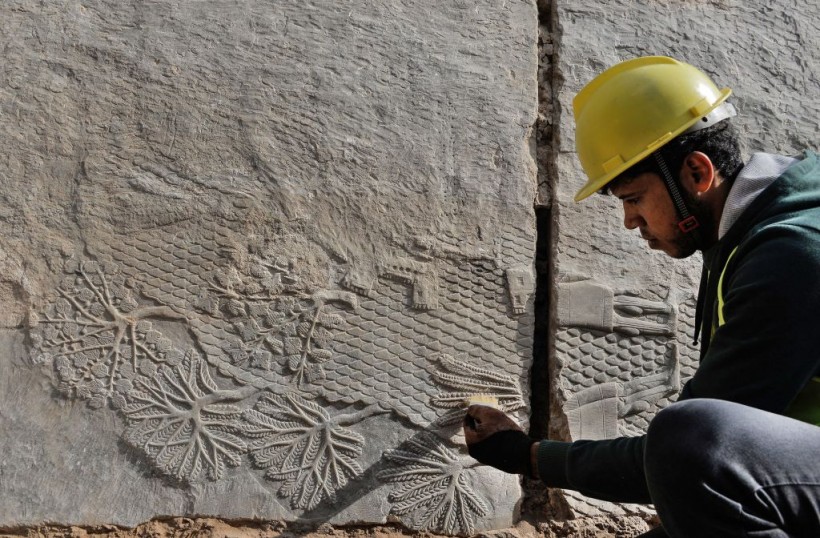A team of Iraqi and American archaeologists recently dug in the ruins of an ancient palatial gate in Iraq and found an Assyrian artwork not seen for 2,600 years. ISIS destroyed the said palatial gate in which National Geographic received photos to confirm the destruction n 2016.
The artwork shows the Assyrian king's military campaigns, believed to be one of the first major discoveries of their kind in the country since the 1800s. More so, archaeologists noted that the seven carved gypsum panels likely came from the Southwest Palace at Nineveh and date to the time of Assyrian king Sennacherib who ruled from 705 B.C. to 681 B.C.

An Iraqi worker excavates a rock-carving relief recently found at the Mashki Gate, one of the monumental gates to the ancient Assyrian city of Nineveh, on the outskirts of what is today the northern Iraqi city of Mosul on October 19, 2022.
Unexpected Discovery of the "Revolutionary" Assyrian Artwork
Ali al-Jabouri, a member of the excavation team and the retired dean of the College of Archaeology of the University of Mosul, remarks that the discovery is something unexpected. He told National Geographic via a call from Mosul that it is a very exciting discovery as it is something that they are able to touch, unlike those in the British Museum.
Similar discoveries were also excavated from the site in the mid-19th century which has now become the highlight of the collections of the British Museum, which are only viewable but untouchable. Those artworks also depict the king's campaign against Judea's King Hezekiah in 701.
Sennacherib is one of the famous leaders in the Neo-Assyrian Empire, which spanned now modern Iraq to the Caucasus and Egypt. Aside from the panels at the British Museum and other walls, his military campaign in 701 was also recorded in some biblical accounts.
Furthermore, his reign was considered a pivotal moment in art history as it was when artists were free from the binding restrictions of tradition and started embracing a sweeping new approach. He commissioned large-scale depictions of his military exploits in continuous narratives that filled every space completely with fine details of landscapes and people.
The newly discovered panel of Assyrian artwork shows an inscription of Sennacherib and depicts his soldiers and military camps, as well as their enemies. Ironically, the preserved portions of the ancient artwork that survived both the attacks of Babylonians and Medes in 612 B.C. and the ISIS attack in the 21st century appeared as if they were just carved.
Archaeology Professor Michael Danti from the University of Pennsylvania pointed out that they look better than the ones in British Museum and show the high-relief carving of the sculptures that were revolutionary at the time.
Assyrian Artwork Staying Home
The discovery is the first significant artwork of known Sennacherib-era reliefs since Austen Henry Layard excavated the Southwest Palace in the 1800s. Most of Layard's discoveries were sent to European museums, but National Geographic reports that the panels will be the first to remain in Iraq.
The Agence France-Presse (AFP) also reported that the panels were in remarkably good condition that depictions of grape vines, warriors and bows, and palm trees can be clearly distinguished. Officials are planning to eventually display the panels as part of a new archaeological park.
Danti said that access to cultural heritage is a human right, which is something that groups like ISIS want to sever the links forever as part of their campaign of cultural cleansing and genocide.
Professor Zainab Bahrani from Columbia University noted that the discovery provides some comfort that these things can never be destroyed as they will reemerge in some sense, proving that history cannot be erased.
RELATED ARTICLE: Farmer Unearths an Ornate Byzantine Floor Mosaic in Gaza While Planting an Olive Tree
Check out more news and information on Archaeology in Science Times.














